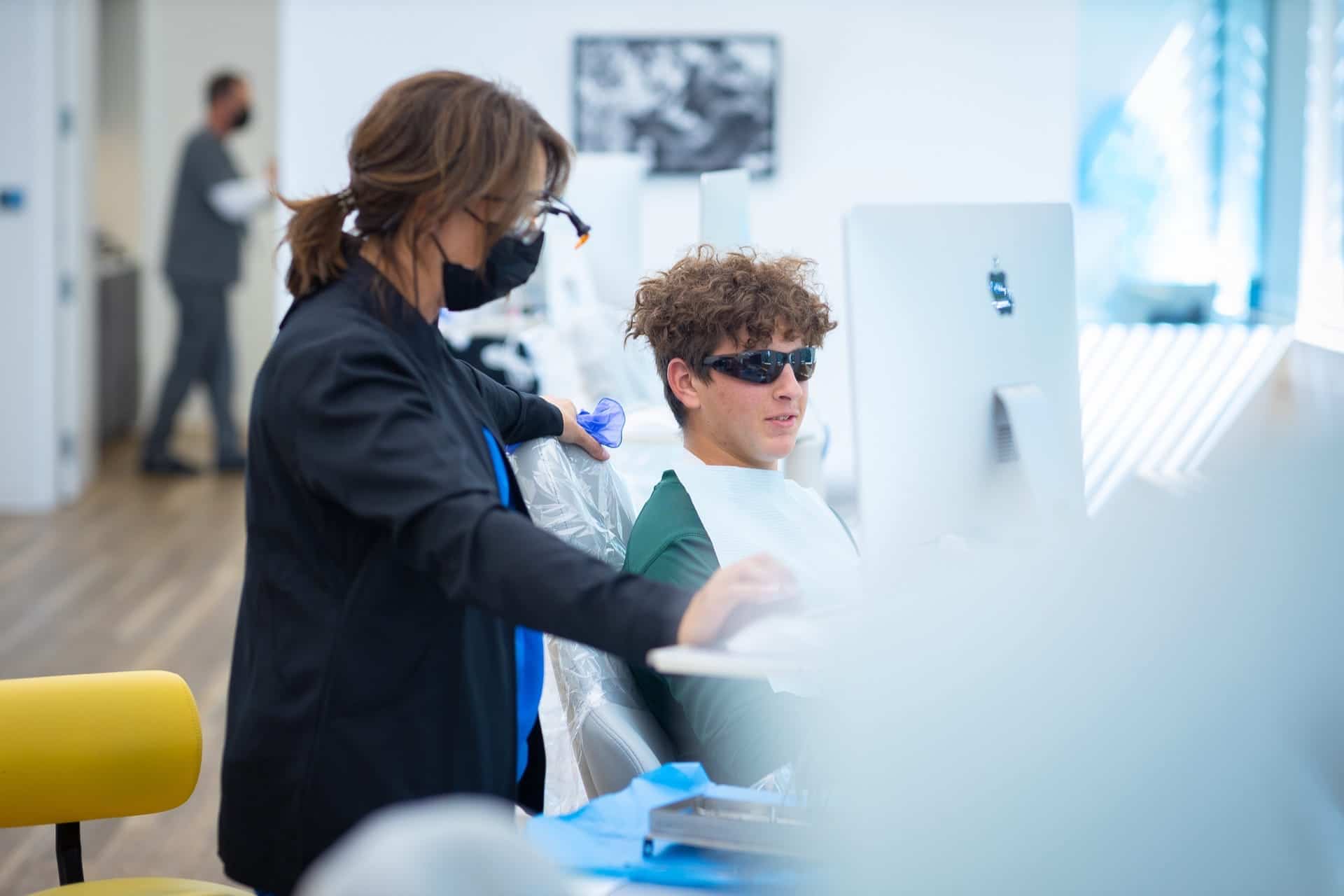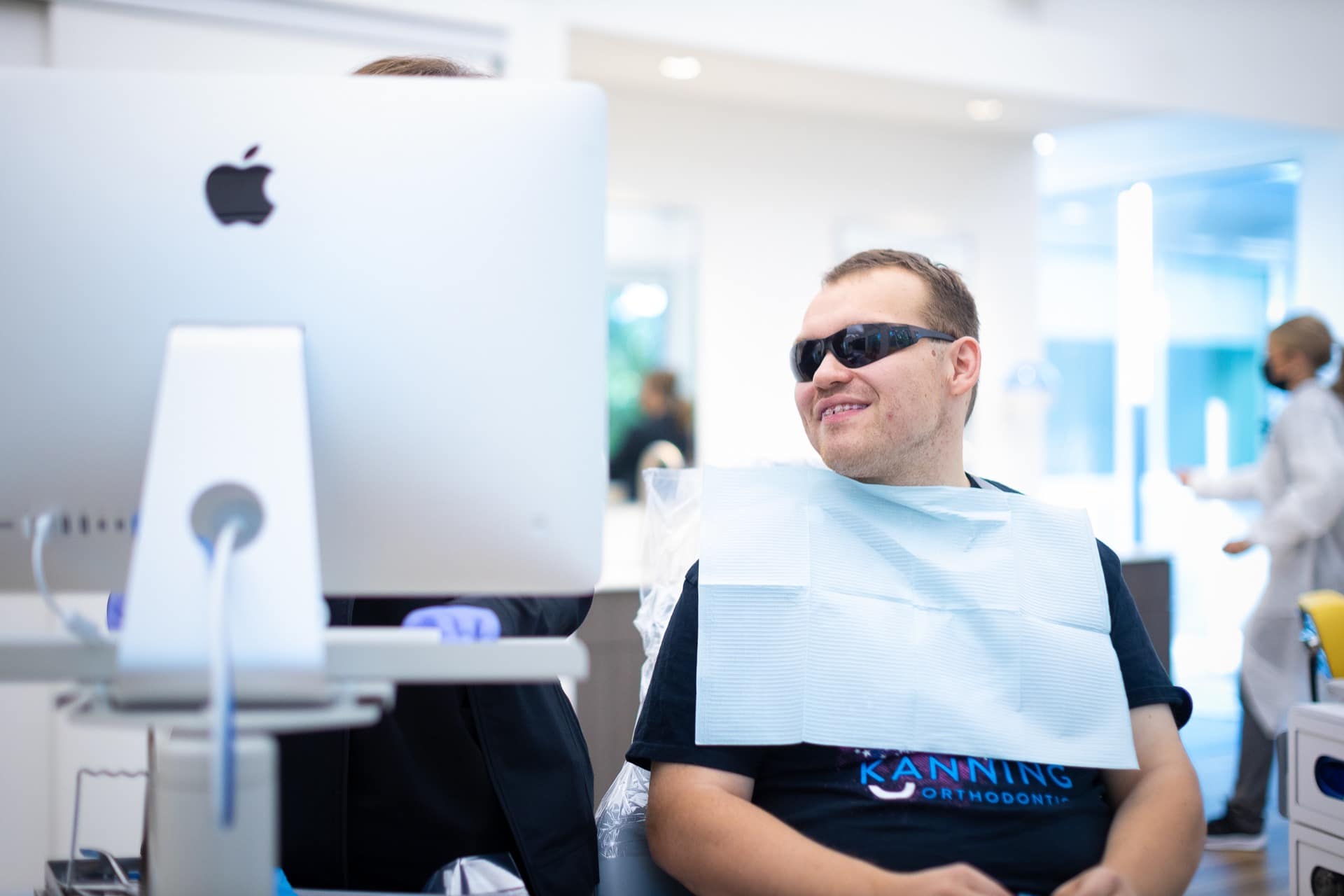We may begin with beautiful, white teeth, but they don’t always stay that way. For most people, what we eat or drink can dull that white and stain teeth over time. Some people even begin to see brown spots on their teeth.
You may notice brown spots between teeth, browning teeth near gums, or brown spots on your teeth. What do they mean, and how do you get rid of them?
Kanning Orthodontics treats patients with spots before or after braces or clear aligners. The reason for brown spots on teeth can vary. The first step is to understand why you are getting brown spots on your teeth. Then, we can help you treat them!
What Causes Brown Spots on Teeth?
There can be many causes for brown spots on teeth. You may even notice brown lining on teeth or brown spots between teeth. These could be caused by something simple, like what you eat or drink, or medical conditions, such as celiac disease.
Here are some of the more common causes of brown on teeth.
Food and Drink Stains
Foods and beverages can stain teeth over time. Coffee, tea, chocolate, certain dark fruits such as berries, tomatoes, and even sodas can cause teeth to stain.
The color soaks into the tooth enamel, the hard outer shell protecting the teeth. It sometimes gets to the dentin, the softer inner part that protects the living pulp of the tooth. While it usually stains the entire tooth, sometimes a brown spot on a tooth can form.
Smoking
Nicotine and other chemicals in smoking, vaping, or other tobacco products can stain teeth. They can also cause brown spots on teeth and can accelerate tooth decay.
Tooth Decay
Acids in your food and drink form bacteria that cause tooth decay. This bacteria stays on your teeth in the form of plaque. If that plaque isn’t removed, the bacteria break down your enamel, causing brown spots and cavities.
Flossing and brushing your teeth regularly is the easiest way to prevent tooth decay. Brushing for at least two minutes each time after meals can significantly reduce plaque buildup. It’s also important to see your dentist.
A lack of brushing can also cause white spots on your teeth if you wear braces. This is also because of bacteria breaking down the enamel around the brackets and wires. To avoid spots before and after braces, make sure you brush and floss regularly.
Tartar
You may wonder, “Why are my teeth turning brown at the gum line?” This may be due to tartar. Tartar is hardened plaque that forms along the gumline. It can cause your teeth to rot as well as cause gum disease.
A professional must remove tartar. See your dentist or visit us if you see tartar buildup forming. A thorough dental cleaning can remove the tartar, but poor oral hygiene can cause it to build up again.
Injury or Failing Dental Work
Damage to your teeth from injuries or damage from failing dental work can cause dark spots on a tooth. The dark spots are usually caused by damage to the nerves in the dentin. It can cause part or all of the tooth to turn brown.
Failing dental work, such as old fillings that break down, can also stain the tooth. You can also have a tooth turn dark before or after a root canal because the nerve is damaged.
Aging
The older you get, the more your teeth are stained. They also become more warn, allowing stains to seep in faster. It’s very common for brown spots to form on teeth as you age.
Celiac Disease
Celiac disease is a disorder that causes a resistance to gluten. Celiac disease can cause tooth discoloration, particularly in children whose teeth are still forming. It’s not unusual to see brown spots between teeth or brown dots on teeth in people with celiac disease.
Enamel Hypoplasia
This genetic condition causes enamel to be thinner than usual. This can make it easier to get brown spots on the teeth.
These are some of the more common reasons why patients get brown spots on their teeth. How Do I Treat Brown Lines on Teeth?
Whether it’s lines, spots, or discoloration along the gum line, professional treatments are available to help reverse brown spots on teeth.
You can treat many brown spots with a good cleaning, such as those caused by tartar buildup or tooth decay. Fillings may be required to treat the tooth decay. You can get fillings while wearing bracesor clear aligners, but getting them done before your treatment is best.
Tooth whitening treatments can reduce brown spots on teeth. Professional whitening treatments can target brown spots and remove deep stains from teeth. Home whitening strips and kits can’t do this without several treatments, which can make your teeth more sensitive, causing pain with hot or cold food or drinks. Professional tooth whitening can do a better job faster, though at-home teeth whitening products can treat milder cases of discoloration.
A dental implant or bridge may be a better option for those with discolored teeth from an injury or root canals. The dentist removes the damaged tooth for a dental implant, and a metal “root” is implanted in the jaw, and a new crown is screwed into it. With a bridge, a dental crown is held in place by crowns that slip over the teeth on either side of the space.
Those with thin enamel should consider fluoride treatments that coat the tooth and protect the enamel better. This is also good for patients prone to tooth decay, such as those who suffer from chronic dry mouth on certain medications or with certain genetic disorders.
Finally, veneers may be a good solution for those with permanently discolored teeth. These shells fit over the teeth and hide the tooth discoloration, giving you a bright new smile. They are also stain-resistant. Veneers don’t last forever, but they will last several years.
The best way to prevent brown spots is to take care of your oral health. Make sure to brush and floss regularly, especially after consuming foods or drinks that can stain your teeth. Brush after those right away to prevent the food or drink’s color from absorbing into the teeth.
Repairing Tooth Damage in Kansas City, MO
Some brown spots on teeth are hard to prevent, while others are easily preventable. Either way, there are ways to treat your brown spots. During your orthodontic treatment, Kanning Orthodontics can help you determine why you’re getting brown spots and provide treatment options to get rid of them. Schedule an appointmentwith Kanning Orthodontics in the Kansas City, MO, and Liberty, MO, areas, and let us help you!



